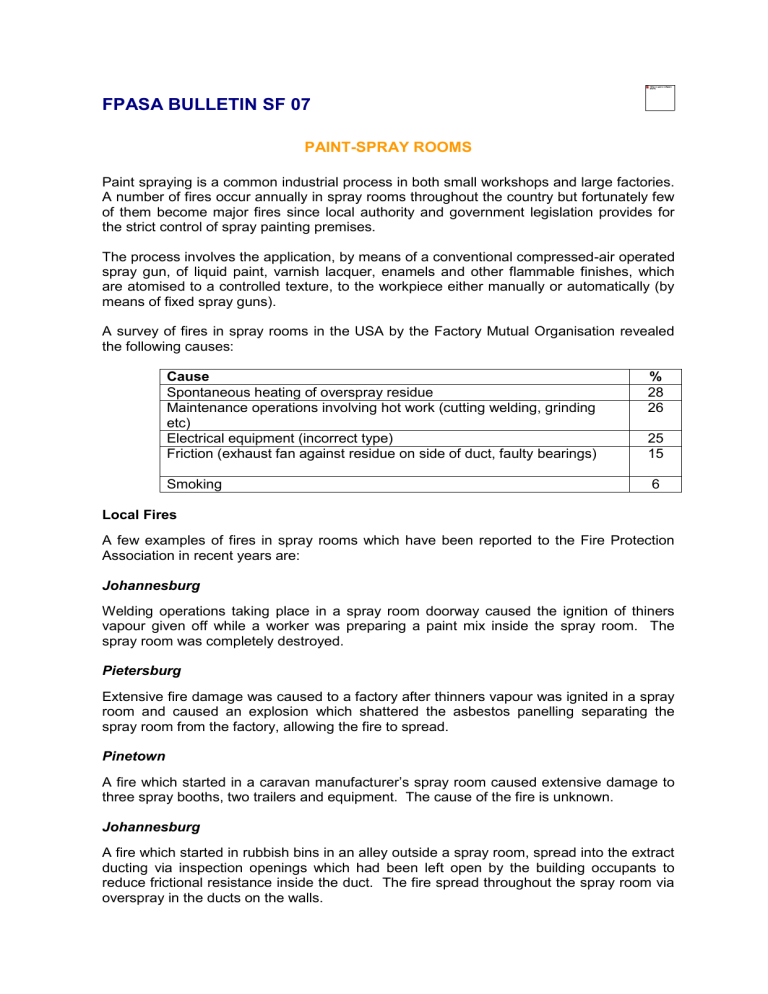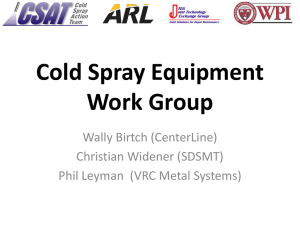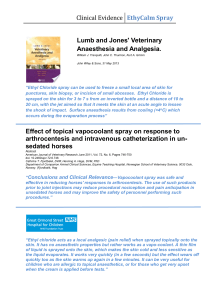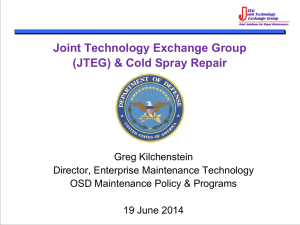FPASA Bulletin SF 07.Paint

FPASA BULLETIN SF 07
PAINT-SPRAY ROOMS
Paint spraying is a common industrial process in both small workshops and large factories.
A number of fires occur annually in spray rooms throughout the country but fortunately few of them become major fires since local authority and government legislation provides for the strict control of spray painting premises.
The process involves the application, by means of a conventional compressed-air operated spray gun, of liquid paint, varnish lacquer, enamels and other flammable finishes, which are atomised to a controlled texture, to the workpiece either manually or automatically (by means of fixed spray guns).
A survey of fires in spray rooms in the USA by the Factory Mutual Organisation revealed the following causes:
Cause
Spontaneous heating of overspray residue
Maintenance operations involving hot work (cutting welding, grinding etc)
%
28
26
Electrical equipment (incorrect type)
Friction (exhaust fan against residue on side of duct, faulty bearings)
Smoking
25
15
6
Local Fires
A few examples of fires in spray rooms which have been reported to the Fire Protection
Association in recent years are:
Johannesburg
Welding operations taking place in a spray room doorway caused the ignition of thiners vapour given off while a worker was preparing a paint mix inside the spray room. The spray room was completely destroyed.
Pietersburg
Extensive fire damage was caused to a factory after thinners vapour was ignited in a spray room and caused an explosion which shattered the asbestos panelling separating the spray room from the factory, allowing the fire to spread.
Pinetown
A fire which started in a caravan manufact urer’s spray room caused extensive damage to three spray booths, two trailers and equipment. The cause of the fire is unknown.
Johannesburg
A fire which started in rubbish bins in an alley outside a spray room, spread into the extract ducting via inspection openings which had been left open by the building occupants to reduce frictional resistance inside the duct. The fire spread throughout the spray room via overspray in the ducts on the walls.
Fire Hazards
All low flashpoint flammable liquids are hazardous, but when atomised, even high flashpoint liquids become easily ignitable as the small droplets vaporise more readily and create flammable or explosive atmosphere.
Inevitably not all the paint is deposited on the workpiece. Overspray and ricochet of paint droplets from the surface of the article being sprayed results in excessive build-up of residue on floors, walls, extraction fan blades and extraction ducting, etc.
Flammable liquids and solvents are often used in the work area either in excessive quantities or in open containers.
“Wipe” rags, filters and solidified residue are prone to spontaneous heating, particularly if contaminated with cellulose nitrate and/or the drying oils used in paints.
Static electricity generated by the movement of flammable liquids can produce an electric discharge.
Lack of effective separation between the spray room and the rest of the plant.
Recommendations
Whilst the general requirements listed below are based on municipal by-laws, it is recommended that the local authority fire department be consulted to ensure compliance with the regulations.
Location
The spray room should be separated from adjoining buildings and other exposures by fireresisting walls. Locating the spray room against an external wall will reduce the overall length of extraction ducting.
Construction
Separating walls should be of 225 mm brick and the roof of reinforced concrete. The doors should open outwards and be either of 50 mm thick hardwood clad with sheet metal or be of metal not less than 3 mm in thickness. Windows should be wired glass in non-opening metal window frames, not exceeding 450 mm x 450 mm. The glazed area is related to floor area with the Factories Act requiring natural lighting to the extent of 15 % of the floor area. Wired glass windows are normally only permitted in external walls.
Ventilation
Spray rooms should be mechanically ventilated. Fan exhaust inlets should be installed at
3,5 m centres with the centre line positioned 450 mm above floor level. The outlet should terminate 1 m above the apex of the roof or at least 3,65 m above ground level.
Ducting, external to the spray room but in communication with the building should be enclosed in 100 mm brick or 50 mm asbestos cement lagging. All ducts should be as short as possible and not have sharp bends.
The ventilation inlets should be air bricks arranged directly opposite the exhaust fans and installed in a honeycomb pattern between 100 mm and 2 000 mm above floor level. At least one ai r brick should be provided for every 1 m³ of room volume. he extraction fans should be capable of providing 30 air changes per hour in the room and should operate for five minutes after the spray painting process has stopped.
Electrical Equipment
All electrical equipment should be of an approved type and should comply with recognised standards. Spray rooms are classified as Class 1, Division 1 Locations in SABS 0108 entitled “The Classification of Hazardous Locations and the Selection of Electrical
Ap paratus for use in such Locations”. The following electrical equipment could therefore be suitable for use in spray rooms:
Intrinsically-safe equipment
This equipment will not cause ignition of a prescribed flammable gas or vapours should sparking occur in the equipment of its associated circuit, since the equipment is designed to prevent sufficient energy capable of producing an incentive spark.
Flame-proof apparatus
This apparatus is enclosed so as to withstand any explosion of a prescribed flammable gas or vapour that may occur within it and will prevent the transmission of flame to a surrounding flammable atmosphere.
Explosion-proof apparatus
This apparatus is enclosed in a case capable of withstanding an internal explosion of a specific flammable gas or vapour surrounding the enclosure. The external surface of the case will, under operating conditions, not reach temperatures high enough to ignite a flammable gas or vapour.
Pressurised apparatus
This apparatus has a higher pressure maintained within its enclosure than that of the surrounding atmosphere thereby preventing the entry of flammable gases or vapours into the enclosure.
All wiring should be completely enclosed in steel conduit screwed into the cases of switches, etc. Unless switches for lighting and motors are of an approved type, they must be installed outside the spray room.
Indirect lighting, through glazed panels, is normally only permitted in patented prefabricated spray booths and not in spray rooms.
Flammable Liquids
Quantities of flammable liquids should preferably not be stored in the spray room, but if this is necessary, the stored quantity should not exceed that required for one shift. All drums and containers should be kept securely closed and stored in metal bins when not in use.
Housekeeping
Overspray should be regularly removed, particularly where cellulose solutions, which are liable to spontaneous ignition, have been used. The cleaning of ducts will be facilitated if inspection covers have been provided for all bends.
Oily and dirty “wipe” cloths should be deposited in metal bins and removed daily.
Combustible materials, other than workpieces, should not be permitted within a spray room.
Smoking should be prohibited in the spray room and surrounding area and notices to that effect should be prominently displayed in 150 mm letters in both official languages.
Fire Protection
A 9 kg dry chemical fire extinguisher should be provided for the spray room and, depending on its size, additional extinguishers may be required. The extinguisher should be mounted on the wall outside the spray room.
Sprinklers are recommended in large spray rooms.
Some solvents used in paint spraying
Flash point
(Closed cup) °C
Explosive limits Vapour
Lower Upper density
(Air:
1,0)
Acetone -18 2,6 12,8 2,0
Amyl acetate
N-Amyl alcohol
23
33
1,1
1,2
7,0
10,0
4,49
3,04
Benzene n-Butyl acetate n-Butyl alcohol
“Cellosolve”
Cyclohexane
Diethyl ether
Ethyl acetate
Ethyl alcohol
Methyl alcohol
Methylated spirits
-11
22
35
41
-17
-40
- 4
13
10
15
1,4
1,7
1,4
2,6
1,3
1,9
2,2
3,3
7,3
3,5
7,1
7,6
11,2
15,7
8,0
48,0
11,4
19,0
36,0
18,0
2,77
4,0
2,55
3,1
2,9
2,56
3,04
1,59
1,11
1,6
Methyl ethyl ketone
Methyl n-propyl ketone
Toluene
White Spirit
0-Xylene
- 7
7
4
38
17
1,8
1,5
1,3
1,1
1,1
11,5
8,2
7,0
6,0
6,4
1,41
2,96
3,14
3,9
3,66
References:
Factory Mutual System, Loss Prevention Data
Fire Prevention No. 132, September 1979, FPA (UK)
Guidance Note Eh9, Health & Safety Executive, HMSO (UK)
Published by
Fire Protection Association of Southern Africa
(Incorporated Association not for Gain)
(Reg. No. 73/00022/08)
P O Box 15467
Impala Park
1472




